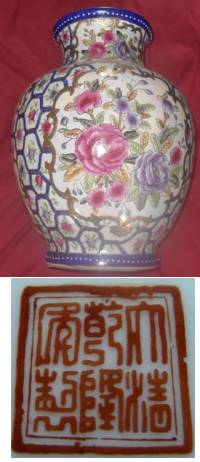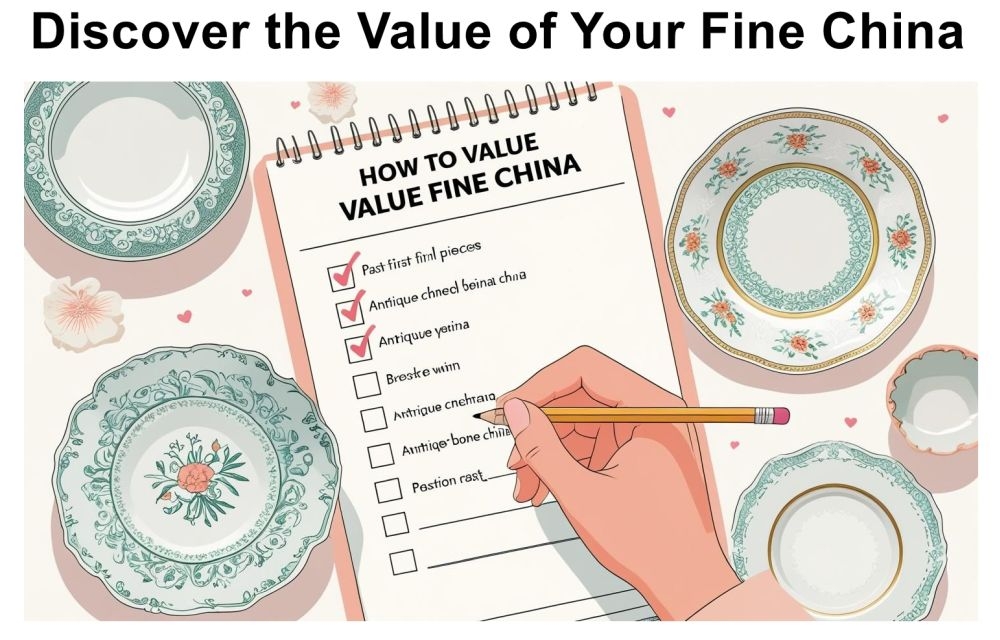Chinese and Japanese Porcelain Marks
Chinese and Japanese porcelain marks are not always what they appear. In the Western mind, a pottery mark is all about identifying and promoting the maker.
In the East, I have come to discover, it is nothing if the sort.
Far East export marks were either often designed to look very Westernized (both Chinese and Japanese), or they are commonly depicting the red seal mark from the centuries old Chinese Qianlong Dynasty when they are much more modern (mainly Chinese, but sometimes Japanese do this).
In the 1950's & 60's in particular, Japanese porcelain marks emulated the look of Western fine china marks (some had a characteristic colour print).
This was because after World War 2 and into the 1960's, Japan was known for making cheap trinkets, rather than high end items.
All that changed rather rapidly of course.
Modern Chinese makers do the same thing today, deliberately aging and distressing both the mark and the wares.

The Chinese made popular export styles of wares which emulated the
famille-rose pallete (originating c.1730) of the Qing dynasty and also
featured the square red seal marks. These items were marked the the
Qing marks right through the 20th century and into modern times, despite
the fact that the Qing Dynasty ended in 1911. So don't be fooled.
So when you see Eastern writing on a backstamp, not only is it impossible to read for most, but also it probably isn't what it says.
Having
said that, we have seen real Qing court china which the owner salvaged
from the garbage bin and turned out to be very valuable.
Apart from being impossible for an ordinaryWesterner to even take a stab at reading, the Oriental writing characters on an item quite often do not say much, if anything, about who made them.
What Are You Most Likely To Come Across?

So many Oriental vases we are likely to have in
our homes or come across in garage sales have a red square seal stamp
on the base which when translated says "Great Qing Qianlong Period
Make".
The Qing dynasty ruled in China from 1736-1795 and
Qianlong was one of the Emperors. It is highly likely the vase shown above was made
in the 20th century.
However, this apparently is not forgery, it is 'homage' and follows a long tradition. The Qing emperors themselves were doing their utmost to reproduce the most exquisite wares of the Ming dynasty (to prove themselves ever so cultured).
Often these were marked
with the old stamps of the Ming and only fine-eyed experts can tell
what's what.
To complicate matters further, the Japanese
sometimes made wares which looked like and are marked like Chinese
porcelain.
The Chinese is an older, more knowledgeable and valuable tradition than the Japanese. This is despite the popularity of Japanese Imari (Arita), Satsuma and Kutani.
Ironically, when Japanese Imari became a popular export, the Chinese got in on the act and started exporting their own version of Imari in the 1700's.
To see the range of visitor China Chat submissions about their mystery Far East pottery marks click here
Return from Chinese and Japanese Porcelain Marks to Pottery Mark Clues, or alternatively, go back to the Homepage

Inherited a china set?... Download my free 7-point checklist to instantly assess its potential value.
From the Studio
• Peter Holland Posters
• Sculpture Studio